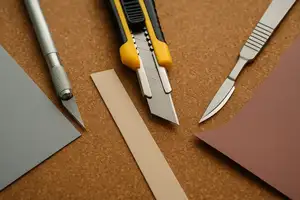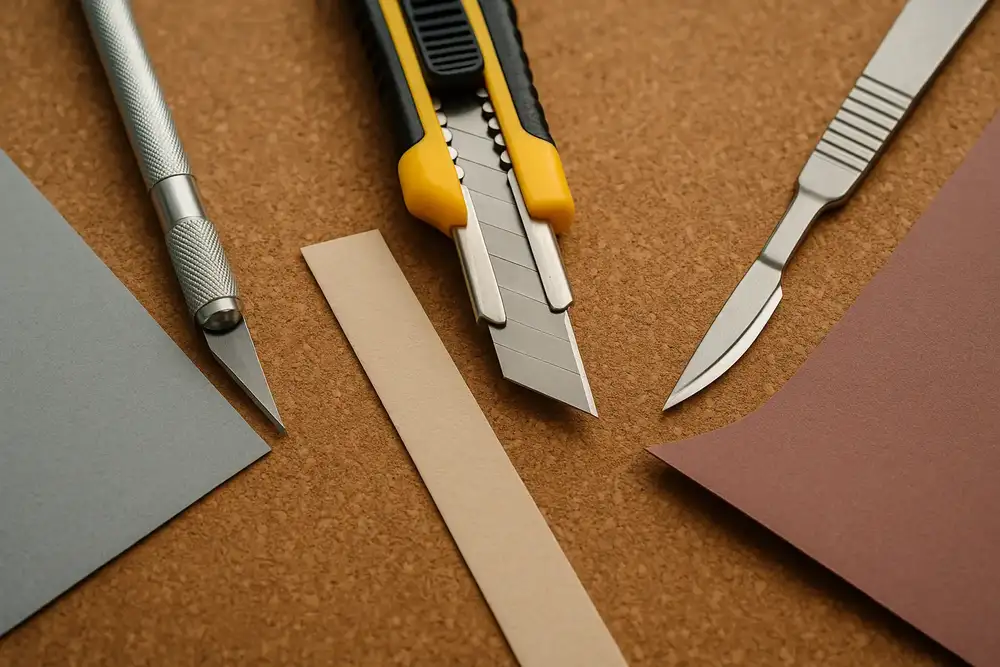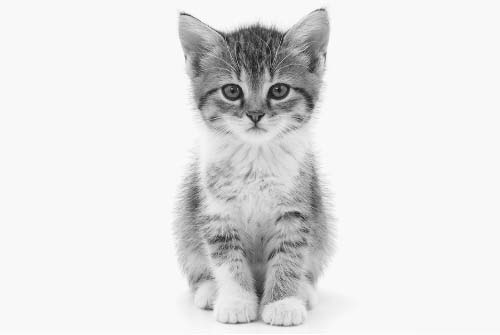Add products by adding codes
Choosing the Perfect Knife: Modeling, Wallpaper or Scalpel?

Choosing the perfect knife: modeling knife, wallpaper knife or scalpel?
Choosing the right knife can be a difficult task, especially for people who are not familiar with the different types of tools available.
Both modeling knife, as well as scalpel are useful in a variety of contexts, from modeling to precision cutting.

Understanding the differences between the two is key to making the right choice. In this article we will discuss the characteristics and applications of various knives.
Key findings
- Choosing a knife depends on your specific needs.
- Modeling knife is ideal for precision work.
- Scalpel is used in professional applications.
- Differences between knives are important for their effective use.
- Knowledge of the properties of knives helps in their selection.
What is the difference between specialty knives?
Specialty knives vary in design, materials and application. These differences are key to their effective use in various fields.
Basic design differences
Specialty knives have different designs that are tailored to specific tasks. For example, modeling knife often has interchangeable blades, which increases its versatility. In turn wallpaper cutter has a usually fixed blade that is designed to cut wallpaper and other paper materials.
Differences in design also include the shape of the handle, which affects the comfort of use and precision of cutting. Ergonomic handles are designed to reduce hand fatigue during prolonged work.
Workmanship materials and their impact on durability
The materials used in the production of specialty knives have a significant impact on their durability and performance. Blades made of high-grade steel are more resistant to wear and tear and retain their sharpness for a longer period of time.
| Material | Durability | Corrosion resistance |
|---|---|---|
| High-quality steel | High | High |
| Stainless steel | Average | High |
| Carbon steel | High | Low |
The choice of the right material depends on the purpose of the knife and the conditions in which it will be used. Knives made of high-quality materials are not only more durable, but also provide better work results.
Modeling knife - characteristics and applications
In the world of modeling, modeling knife is an essential tool for precision cutting of plastics, wood and other materials. Its versatility and precision make it indispensable in any modeling workshop.
Construction of a modeling knife
Modeling knife consists of several key components: handle, blade, and safety system. The handle should be ergonomic and comfortable to use, allowing precise guidance of the knife.
Blade is the most important part of a modeling knife. It is usually made of high-quality steel, which ensures its durability and sharpness.
Types of modeling blades
Modeling blades come in a variety of shapes and sizes to suit different modeling tasks. Below is a comparison table of popular blade types:
| Blade type | Application | Features |
|---|---|---|
| Straight blade | Cutting straight lines | Simple, versatile |
| Curved blade | Cutting curved lines | Curved, ideal for cutting rounds |
| Lanceolate blade | Precision cutting small components | Thin, precise |
Typical modeling applications
The modeling knife is used in many aspects of modeling, from cutting plastic and wood to molding model details. Precision cutting is the key to creating realistic and detailed models.
Modelers often use a modeling knife to:
- cutting model elements
- forming of details
- surface preparation for bonding
Thanks to its precision and versatility, the modeling knife is an indispensable tool in the world of modeling.
Wallpaper cutter - specifics and purpose
Wallpaper cutter, although designed for wallpaper, is used in many other areas. Its precision blade and ergonomic design make it useful for a variety of hand jobs.
Wallpaper cutter design
Knife design for wallpaper is adapted for precise cutting. Ergonomic handle provides comfort during work, and interchangeable blades allow you to customize the tool for different tasks.
Types of blades for wallpaper work
Wallpaper blades are available in different types, allowing them to be used in a variety of jobs. Hooked blades are ideal for cutting wallpaper along the edge, while the straight blades are better for cutting in a straight line.
Applications beyond wallpapering
Although wallpaper cutter is designed with wallpaper in mind, its application is much broader. It can be used to cutting paper,films, and even thin materials such as leather or thin wood.
Scalpel - a precision tool not only for medics
Scalpel is an extremely precise tool, used not only in medicine, but also in other areas of life. Its versatility comes from its precise design and adaptability to various tasks.
https://www.youtube.com/watch?v=InuAUs4eYM8
Anatomy of a scalpel
Scalpel consists of several key components: the handle, the blade and sometimes additional elements such as caps or guards. Scalpel handle is designed to provide a comfortable grip and control of the tool.
The scalpel blade is its most important part, determining the precision of the cut. The blades can be interchangeable, allowing you to customize the scalpel for a specific task.
Types of scalpel blades
Scalpel blades come in a variety of shapes and sizes for use in different fields. Several types of blades are listed below:
- Straight blades - used for straight cuts.
- Curved blades - ideal for cuts in hard-to-reach places.
- Lanceolate blades - used in precision cutting.
Applications of the scalpel outside of medicine
In addition to medicine, the scalpel has found use in arts, crafts and laboratory work. Artistic use of the scalpel includes:
- Cutting precise shapes in a variety of materials.
- Creating details in models and mockups.
- Precision cutting in scrapbooking and cardmaking work.
Thanks to its precision and versatility, the scalpel is a tool valued not only by medical professionals, but also by artists and hobbyists.
Ergonomics of the handle - the key to comfortable work
Comfortable work with the specialty knives starts with the ergonomic handle. The handle of the cutter is a component that directly affects the comfort of work and the precision of cutting. Therefore, its design and the materials used in its production are of great importance.
A well-designed handle should provide stable hold of the knife in your hand, minimizing the risk of slipping and allowing precise cutting. Handle shape can be adapted to different types of work, such as precision cutting or work that requires more pressure.
Effect of handle shape on cutting precision
Handle shape of the cutter has a direct impact on precision of cutting. The handle should be designed to allow you to comfortably hold the knife and control the blade. This can be achieved by the proper contouring of the handle, which provides a stable grip.
Handle materials and their properties
The materials used for knife handles can range from plastic to metal to wood. Each of these materials has its own properties, such as durability, resistance to moisture or comfort in holding. The choice of the right material depends on the purpose of the knife and the user's preference.
For example, handles made of plastics are lightweight and easy to clean, while those made of metal offer greater durability. Wooden handles, on the other hand, provide natural comfort holding, although they may require additional maintenance.
Interchangeable blades - types and compatibility
Interchangeable blades is a key component of specialty cutters, enabling precision cutting in a variety of applications. Their variety and compatibility with various tools make them indispensable in many fields, from modeling to surgery.
Interchangeable blade standards
Blade standards interchangeable parts are key to ensuring compatibility and cutting quality. Manufacturers of knives specialized use different standards that determine the shape, size and attachment of blades. For example, medical scalpels often use standard blade sizes, such as No. 10 or No. 15.
Popular interchangeable blade standards:
- Bard-Parker blades for surgical scalpels
- "X-Acto" blades for modeling and art knives
- "Stanley" blades for wallpaper cutters and other applications
Marking and numbering of blades
Blade markings and numbering are extremely important for quick identification and selection of the right blades for specific tasks. The numbers and designations of the blades refer to their shape, blade angle and purpose.
Example designations:
- Blade No. 10 - commonly used in surgery
- No. 11 blade - ideal for precision cuts
- Blade No. 15 - often used in modeling
Versatility vs. blade specialization
Versatility and blade specialization are two opposing approaches in replacement blade design. Universal blades are designed for a wide range of applications, while specialized blades are dedicated to specific tasks.
Advantages of universal blades:
- Multitasking
- Availability
- Ease of replacement
Advantages of specialty blades:
- High precision
- Optimization for specific materials
- Increased efficiency
Safety in working with specialty knives
Occupational safety with specialty knives is key to avoiding accidents. These knives, while precise and useful, can be dangerous if not used properly.
Safety systems in cutters
Many specialty knives are equipped with safety systems, that minimize the risk of cuts. One such solution is the mechanism of automatic retraction of the blade after the cut is completed. In addition, some models have ergonomic handles designed to provide a secure grip.
Examples of security systems:
- Blade locking mechanisms
- Blade guards
- Ergonomic handles
Rules for safe use and storage
To ensure the safe use of knives, follow some basic rules. First, always use the right knife for the job to avoid excessive pressure that can lead to accidents.
| Principle | Description |
|---|---|
| Use the knife as intended | Avoid using the knife for tasks for which it is not intended. |
| Store your knives safely | Knives should be stored in special containers or cases. |
| Regularly check the condition of the knife | Check the blade for damage or excessive wear. |
To summarize, job security with specialty knives requires both the use of appropriate security systems, as well as adherence to safe use and storage.
Modeling knife, wallpaper knife or scalpel - which one to choose for precision work?
Modeling knife, wallpaper knife, or perhaps a scalpel - which is best for work requiring precision? Choosing the ideal tool depends on several factors, including cutting precision and the availability and ease of blade replacement.
Comparison of cutting precision
Cutting precision is a key consideration when choosing a knife for precision work. Modeling knife is designed specifically for modeling and features a blade that allows precise cutting of various materials.
- Modeling knife: ideal for detailed modeling work.
- Wallpaper cutter: is primarily used for cutting wallpaper, but can also be used for other materials.
- Scalpel: used not only in medicine, but also in various handicrafts that require high precision.
Comparing the precision of cutting, the scalpel stands out as the the highest accuracy thanks to its sharp and thin blades.

Blade availability and replacement
Availability and ease of blade replacement is another important factor. Modeling knives and scalpels often have interchangeable blades, which increases their functionality.
| Type of knife | Blade availability | Ease of replacement |
|---|---|---|
| Modeling knife | Large | Easy |
| Wallpaper cutter | Average | Moderate |
| Scalpel | Large | Easy |
Therefore, the choice of the right blade should take into account both the precision of cutting and the availability and ease of replacement of blades.
Use in artwork and handicrafts
Specialty knives are indispensable tools in the world of arts and crafts. Their precision and variety of applications make them ideal for those creating artistic works of art.
Scrapbooking and cardmaking
In scrapbooking and cardmaking, specialized knives are used to precisely cut out decorative elements such as patterns, shapes and letters. Enable the creation of unique and personalized designs.
Cutouts and stencils
These knives are also used to create intricate cutouts and stencils. With them, artists can precisely cut out details to create beautiful and intricate designs.
Work in leather and other materials
In addition to paper work, specialty knives are also used for leather and other materials. They allow precise cutting and shaping of parts, which is especially important in handicrafts.
Using specialty knives in arts and crafts opens up new creative possibilities. With them, artists and hobbyists can realize their ideas with greater precision and detail.
Specialty knives in repair work
Repair work often require precise cutting, and specialized knives are the ideal tool for this purpose. Their versatility and precision make them indispensable for a variety of finishing work.
Precision cutting for finishing
During renovation work, precision cutting is key, especially for finishing work. Specialty knives allow you to accurately cut a variety of materials, including wallpaper, film, or even thin boards.
The use of specialty knives in finishing allows:
- Precision cutting of materials without damaging them
- Waste reduction
- Increase work efficiency
Work with finishing materials
Finishing materials, such as skirting boards, wall panels, or decorative films, often require precise cutting. Specialty knives, thanks to their blades, make it possible to cut these materials without risk of damage.
| Material | Type of knife | Comments |
|---|---|---|
| Wallpaper | Wallpaper cutter | Precision cutting without delamination |
| Decorative films | Modeling knife | Requires a sharp blade |
| Skirting boards | Scalpel | Allows precision cutting at an angle |
Specialty knives are therefore an indispensable tool in renovation work, allowing precise and efficient cutting of a variety of finishing materials.
Comparison of knives when cutting different materials
Different materials present different challenges to cutters, so it's important to understand their specifics. Choosing the right tool can significantly affect the quality and precision of the cut.
Paper and cardboard
For paper and cardboard, the best knives are those with blades that are very sharp and thin, allowing precise cutting without tearing the material. Modeling and wallpaper cutters are often used for these purposes.
Plastics
Plastics require knives with more durable blades that can handle the hardness of plastic. Scalpels or knives with replaceable blades are often used in this case.
Wood and composite materials
For wood and composite materials, the best knives are those with very hard blades, often made of materials such as carbon steel or diamond. These knives must be very sharp to avoid splitting the wood.
Here is a comparison of the effectiveness of different knives when cutting different materials:
| Material | Modeling Knife | Wallpaper cutter | Scalpel |
|---|---|---|---|
| Paper | Very good | Good | Medium |
| Cardboard | Good | Very good | Medium |
| Plastics | Medium | Medium | Very good |
| Wood | Weak | Weak | Good |
As you can see from the above comparison, each type of cutter has its own specific applications and is better or worse suited for cutting different materials. Choosing the right blade is therefore crucial to achieving the best results.
How to care for specialty knives?
Proper care of specialty knives affects their performance and durability. These knives, whether they are used for modeling, wallpapering or as scalpels, require regular maintenance to keep them sharp and functional.
Cleaning and maintenance
Cleaning the knives specialized should be carried out regularly to remove residual materials that may affect their performance. For cleaning, you can use a soft cloth i mild detergent. In the case of dried residues, you can use specialized cleaners designed for knives.
Knife maintenance also includes sharpening i lubrication moving parts. Sharpening should be performed in accordance with the manufacturer's recommendations, using appropriate tools.

Storage and transportation
Storing the knives specialized should be carried out in a way that is safe and protects the blades from damage. You can use for this purpose special cases or boxes designed for knives.
| Storage method | Advantages | Disadvantages |
|---|---|---|
| Knife case | Blade protection, convenient transportation | Additional cost |
| Knife box | Secure storage, organization | It takes the place of |
The transportation of knives should be equally safe. It is recommended to use sealable containers or covers, to prevent the knives from falling out or getting damaged.
Popular brands of specialty knives on the Polish market
There are many brands of knives available on the Polish market to meet the various needs of users. Both professionals and hobbyists can find the right tools for themselves.
Manufacturers of modeling knives
Modeling knives are extremely popular among modelers and miniature makers. X-Acto i Olfa are two of the best-known brands that offer high-quality model knives. Their products feature sharp blades and ergonomic handles, making it easy to cut precisely.
Manufacturers of wallpaper cutters
Wallpaper cutters are essential for wallpapering work. Brand Stanley is valued for its sturdy and durable knives that make it easy to cut wallpaper with precision. Another well-known manufacturer is Martinez, which offers high quality knives.
Manufacturers of scalpels for hobby use
Scalpels are used not only in medicine, but also in various hobbies, such as scrapbooking whether modelling. Swann Morton is a brand known for producing high-quality scalpels that are prized by hobbyists and professionals alike. In addition, Kai offers scalpels dedicated to precision work.
Choosing the right brand of specialty knife depends on the individual needs and preferences of the user. It is worth noting the quality of workmanship, availability of blades and ergonomics of the handle.
Where to buy good quality specialty knives?
If you are looking for good quality specialty knives, you have several options for purchase. Both stationary stores, as well as online offer a wide range of knives to suit different needs.
Stationary stores
Stationary stores are a great place where you can personally see and touch the knives before you buy them. You can visit stores specializing in modeling, wallpapering or office supplies to find the right tools.
Advantages of shopping in stationary stores:
- Possibility to see the product before purchase
- Immediate availability
- Advice from store staff
Online stores
Online stores offer the convenience of shopping from anywhere. You can browse a wide range of specialty knives, read reviews from other customers and compare prices.
Advantages of shopping at online stores:
- Convenience and flexibility
- Wide range of products
- Opinions and reviews from other customers
When shopping online, make sure you choose reputable stores with good reviews to avoid problems with quality or delivery.
What to look for when buying a specialty knife?
Choosing the perfect specialty knife can be a challenge, so it's worth noting a few important aspects. Purchase of a knife, that will meet our expectations requires consideration of several key criteria.
Selection criteria
When choosing a specialized knife, pay attention to its intended use. Whether it will be used for modeling, wallpapering, or perhaps for precision laboratory work? Each of these applications requires a different type of knife.
Type of material, from which the knife is made also matters. The knives can be made of stainless steel, metal alloys and even plastics. The choice of material depends on the purpose of the cutter and the user's preference.
Value for money
Evaluation value for money is a key consideration when purchasing a specialty knife. The user should look for a knife that offers the best quality for the price.
When comparing different models, it is worth paying attention to the reviews of other users and the technical specifications of the product. Knife price can be an indicator of its quality, but this is not always the rule.
- Check the materials of the knife.
- Pay attention to the ergonomics of the handle.
- Read feedback from other users.
To sum up, buying a knife specialized requires attention and analysis. Choosing the right cutter can significantly affect the comfort and efficiency of your work.
Application
In summary, choosing the ideal specialty knife depends on individual needs and specific applications. In this article, we discuss various aspects of modeling knives, wallpaper cutters and scalpels to help the reader make an informed decision.
Choosing a knife should be dictated by the type of work to be performed. Modeling knives work well for precision cuts in modeling, while wallpaper cutters are ideal for wallpaper work. Scalpel, on the other hand, is used not only in medicine, but also in various handicraft work requiring precision.
Summary of our considerations indicates that regardless of the chosen category of knife, the key aspect is its ergonomics, quality of manufacture and availability of replaceable blades. Choosing the right cutter is an investment in precision and comfort.
FAQ
What are the main differences between a modeling knife, a wallpaper cutter and a scalpel?
A modeling knife is designed for cutting various materials in modeling, a wallpaper cutter is mainly used for cutting wallpaper, and a scalpel is a precision tool used in medicine and other fields that require precision.
Can a modeling knife be used to cut wallpaper?
Yes, a modeling knife can be used to cut wallpaper, but a wallpaper cutter is usually more suitable for this purpose because of its design and blades.
What materials are most commonly cut with specialty cutters?
Specialty knives most often cut materials such as plastic, wood, paper, cardboard, plastics and leather.
How to care for specialty knives to extend their life?
To prolong the life of specialty knives, clean and maintain blades regularly, store tools properly, and use proper cutting techniques.
Where to buy high-quality specialty knives?
High-quality specialty knives can be purchased from stationary stores specializing in tools or from online stores of reputable manufacturers.
What to look for when buying a specialty knife?
When buying a specialty knife, pay attention to the material of construction, design, type of blade and ergonomic handle, as well as value for money.
Is the scalpel safe to use for those without medical experience?
The scalpel can be safe for use by people without medical experience if they are aware of the rules of safe use and storage and use proper techniques.
What are the popular brands of specialty knives available on the Polish market?
On the Polish market there are various brands of scissors specialty, including manufacturers of cutters modeling, wallpaper cutters and scalpels dedicated to hobby applications.
























